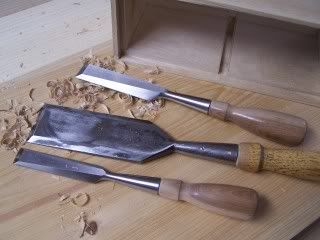The Case for Paring Chisels
Galoots and Hybrids everywhere have hand planes. Usually more than one, and oftentimes a lot more than one. We have planes for different quality of finishes, planes for joinery, planes for tough grain, and planes for hugging tightly and whispering to.
Oops, shouldn’t have said that last one.

Can the same thing be said about chisels? Maybe in the real galoot’s shop, but in a shrinking number and even more so in the hybrid woodworker’s shop. I have read all about the different kinds of chisels and their traditional uses from mortise to firmer and back again. Paring chisels in particular have interested me because of their delicate beauty and the way in which they are used to fine tune the stock. I haven’t picked up any though because I haven’t really seen the need for them in my work yet. Today that changed…
I was squaring up the ends of a stopped rabbet on the back of a box using my chisels. The wood I was using is a very soft Paulownia and I kept splitting apart the shoulder at the end of the rabbet. I was able to glue that shoulder back in place making a seamless repair, but in my continuing work on the other corners I kept getting really close to repeating the mistake. It occurred to me at that point that with my chisels honed with a 35 degree microbevel I may be pushing the limits of my stock. Just like you change the bevel on a plane for working with end grain or hard or soft woods, the same can be said for your chisels. I managed to finish 2 of the 4 corners in the rabbet by taking very, very light cuts, but I was still getting some tearout. Finally I switched to the one chisel in my shop that is honed to a 20 degree angle (see RWW # 13: Rehabbing an Old Chisel) and the blade just cleanly slipped between the fibers and smoothly cut where I wanted it to. Unfortunately, this chisel is a 2″ wide Firmer and not really suited for small details.
Regardless, I had an epiphany that paring chisels aren’t just the chisels that you never hit with a mallet. The bevel angle of the chisel is actually the best way to control how your tool works in a specific wood. I would never want to use a 20 degree bevel in hard maple because I would ruin the edge quickly and the converse is true as I was experiencing. Too steep a bevel will try to lift away the wood in a softer species and lead to blow out in a delicate spot.
I am certainly not going to go through the arduous (and wasteful) process of grinding my nice Lie-Nielsen chisels back to 20 degrees only to have to re-grind again back to 30 or 35 later just like I wouldn’t do the same to a smoothing plane to control tearout. It is this fact that has me thinking that maybe it is time for some dedicated paring chisels in my shop. Whether that comes in the form of some of the beautiful new ones on the market or just buying up some flea market chisels and setting the bevel at 20 degrees is yet to be determined.


